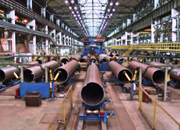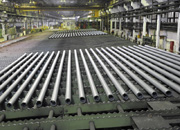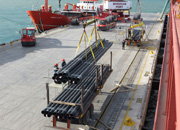As a core pressure-bearing component material in power plant boilers, the performance of
P92 high-pressure boiler steel tubes directly affects the safe operation and energy efficiency of ultra-supercritical units. This new type of martensitic heat-resistant steel has achieved breakthroughs in high-temperature strength, creep resistance, and weldability through composition optimization and process innovation, and has now become a key material choice for units with steam parameters above 600℃ worldwide.
Material Characteristics and Technological Innovations of P92 High-Pressure Boiler Steel Tubes
P92 steel is an improved steel grade based on P91, with the addition of 1.7% tungsten and a reduction in molybdenum content. Its chemical composition system (Cr: 8.5-9.5%, W: 1.5-2.0%, Mo: 0.3-0.6%) achieves a creep strength increase of over 30% compared to traditional steel grades through the synergistic effect of solid solution strengthening and precipitation strengthening. In terms of microstructure, this material, through controlled rolling and cooling processes, forms a lath martensitic matrix. Combined with the dispersed distribution of MX-type carbonitrides and Laves phases, it maintains a creep strength of ≥100 MPa for 100,000 hours even at 650℃. Particularly noteworthy is the excellent match between its coefficient of thermal expansion (12.5 × 10⁻⁶/℃) and thermal conductivity (26 W/m·K), effectively mitigating thermal stress issues during unit start-up and shutdown.
Key Breakthroughs in the Production Process of P92 High-Pressure Boiler Steel Tubes
1. Employing EF+LF+VD triple smelting technology to control gas content to [H]≤1.5ppm and [O]≤20ppm
2. Achieving precision forming with a wall thickness tolerance of ±5% using a radial forging mill in conjunction with a three-roll continuous rolling mill
3. Regulating the dual heat treatment process of normalizing (1080℃±10℃) + tempering (760℃±15℃)
4. Ensuring a defect detection rate of ≥99.5% through automatic ultrasonic flaw detection and eddy current testing
Typical Engineering Application Cases of P92 High-Pressure Boiler Steel Tubes
- Wall thickness reduced to 52mm (18% weight reduction compared to the P91 solution)
- Post-weld heat treatment window widened to 740-780℃
- On-site installation, welding first-pass yield rate increased to 98.6%
Special breakthrough in welding technology for P92 high-pressure boiler steel pipes.
Addressing the welding difficulties of P92 steel, domestically developed specialized welding materials (such as CHH727 welding rods) were matched with a multi-layer, multi-pass welding process, increasing the joint toughness to 72J (-20℃). A key project adopted:
1. Preheating temperature 150-200℃
2. Interpass temperature control ≤300℃
3. Post-heat treatment for hydrogen removal at 250℃×2h
4. Post-weld heat treatment at 760℃×4h
This resulted in a weld joint strength coefficient of 0.92 and heat-affected zone hardness controlled within 250HV10. Furthermore, the laser-arc hybrid welding technology developed by Nanjing University of Technology further increased welding efficiency by 40% and reduced deformation by 60%.
Construction of Quality Control System for P92 High-Pressure Boiler Steel Tubes
- Raw Material End: Implementing precise control of Nb/Ti microalloying (±0.01%)
- Manufacturing End: Using infrared thermal imagers to monitor the heat treatment temperature field in real time
- Inspection End: Introducing phased array ultrasonic testing to identify 0.5mm equivalent defects
- Big Data Platform: Integrating 32,000 sets of operational data from 56 power plants nationwide
Cost-Benefit Analysis of P92 High-Pressure Boiler Steel Tubes
1. Increased design pressure allows for reduced wall thickness, reducing material usage by 15-20%
2. Maintenance cycle extended to 8 years (compared to 5 years for conventional materials)
3. Reduced replacement frequency reduces downtime losses by approximately 12 million RMB per instance
Future Development Trends of P92 High-Pressure Boiler Steel Tubes
With the advancement of 700℃ ultra-supercritical technology research and development, the improvement direction of P92 steel focuses on:
1. Adding 0.003% B to improve grain boundary strength
2. Developing nanoscale Y₂O₃ dispersion strengthening technology
3. Exploring the Application of Additive Manufacturing in Shaped Pipe Fittings
Currently, my country's annual production capacity of P92 high-pressure boiler steel pipes has exceeded 80,000 tons, with products exported to more than 20 countries in Southeast Asia and the Middle East. Driven by the "dual carbon" target, this high-performance material will continue to provide key support for the upgrading of clean coal power technology, and its technological evolution path has also accumulated valuable experience for the application of next-generation nickel-based alloys. Industry experts predict that by 2030, the global market demand for P92 materials will maintain an average annual growth rate of 6.5%, and Chinese manufacturing, with its complete industrial chain advantages, is expected to occupy more than 40% of the market share.
 Threeway Steel is known as a professional supplier engaged in manufacturing and distributing a wide range of steel pipe, and our headquarter located the central part of China – Hunan and six associated factories throughout China.
Threeway Steel is known as a professional supplier engaged in manufacturing and distributing a wide range of steel pipe, and our headquarter located the central part of China – Hunan and six associated factories throughout China.
 Threeway Steel is known as a professional supplier engaged in designing, manufacturing and distribution of a wide range of steel products with the headquarter located the central part of China – Hunan and six associated factories throughout China.
Threeway Steel is known as a professional supplier engaged in designing, manufacturing and distribution of a wide range of steel products with the headquarter located the central part of China – Hunan and six associated factories throughout China.
 Threeway Steel is known as a professional supplier engaged in designing, manufacturing and distribution of a wide range of steel products with the headquarter located the central part of China – Hunan and six associated factories throughout China.
Threeway Steel is known as a professional supplier engaged in designing, manufacturing and distribution of a wide range of steel products with the headquarter located the central part of China – Hunan and six associated factories throughout China.
 Threeway Steel is known as a professional supplier engaged in designing, manufacturing and distribution of a wide range of steel products with the headquarter located the central part of China – Hunan and six associated factories throughout China.
Threeway Steel is known as a professional supplier engaged in designing, manufacturing and distribution of a wide range of steel products with the headquarter located the central part of China – Hunan and six associated factories throughout China.
 Threeway Steel is known as a professional supplier engaged in designing, manufacturing and distribution of a wide range of steel products with the headquarter located the central part of China – Hunan and six associated factories throughout China.
Threeway Steel is known as a professional supplier engaged in designing, manufacturing and distribution of a wide range of steel products with the headquarter located the central part of China – Hunan and six associated factories throughout China.

